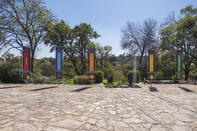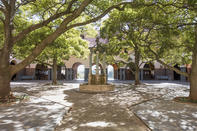First Lay Headmaster
The first lay headmaster of St John's, appointed in 1954, was Deane Yates MA (Oxon), who came from Mill Hill, a well-known English public school. Yates immediately took up the challenge of the crisis in accommodation - with more than 660 pupils in buildings designed for 500, urgent action was needed.

To bring the accommodation up to acceptable standards, new classrooms, laboratories and lecture rooms, a new boarding house and a new swimming pool were required. A sum of £250 000 was the target. The St John's College Foundation launched an appeal for the amount, and succeeded in raising £220 000; a further £35 000 was donated by the Industrial Fund for Scientific Aid, to be used for the building and equipping of a new science block.
First SA Born Head
In 1970, Yates retired his position as headmaster of St John's and headed for Botswana, where he founded Maru-a-Pula ('Place in the Clouds') School, which has become known as an exceptional educational institution in that country.
Yates's successor, Jan Breitenbach MA, UED (Rhodes), was the first South African-born head of the school, He came to St John's from St Andrew's College in Grahamstown, where he had been head of the history department. In 1983 he returned to the city of his alma mater to take up the position as head of the 1820 Settlers' Foundation. Breitenbach was another noted educationist and a member of the Joint Matriculation Board (from 1972 until his departure in 1983).
A Reflection of Change

As a reflection of a changing society (with specific regard to economic considerations), during Breitenbach's tenure a major change was a decline of the boarder to day-boy ratio, from 50/50 to 20/80. Breitenbach was a proactive head, innovating lectures on current affairs, careers guidance and physical education, and introducing the teaching of Zulu and computer science. Another reflection of the changing society was that, for the first time, black pupils were admitted to the sixth form.
Walter Macfarlane took up the post of headmaster at St John's following Breitenbach's departure. Macfarlane came from St Stithians Preparatory School, where he had served with some distinction from 1963. During his head mastership at St John's he has fostered closer relations with the Old Johannians (being one himself), and helped to create a Parents' Association, both of which are represented on the college council. He has been responsible for the acceleration of the admission of black pupils into the school, and has established a bursary fund to assist disadvantaged children to attend St John's.
In recent years, Macfarlane has been responsible for the development of the school's Outreach Programme, involving schools in Alexandra township, in which children who attend schools in the township are aided academically and on the sports field by the staff and senior pupils of St John's College.
Macfarlane's concrete achievements have included an expansion programme that has seen the building of new squash courts, a music school, revamped menial staff quarters, and the planning of a 'hi-tech' science block that will help to carry the school well into the future.